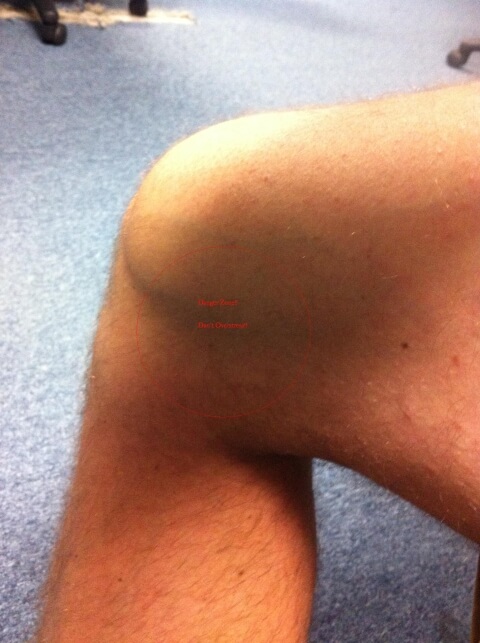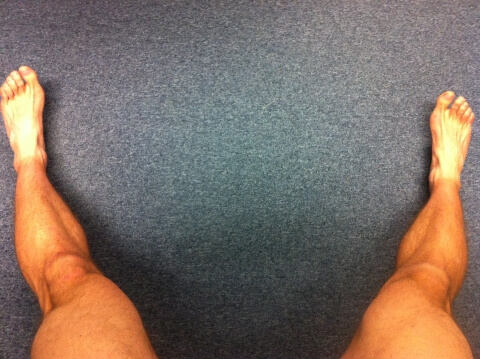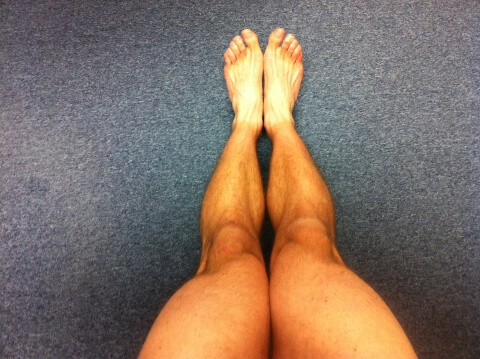Science of Performance: Tips for Breaststroker’s Knee Part I
By Swimming World correspondent G. John Mullen of SwimmingScience.net and COR, Creator of Swimmer’s Shoulder System
SANTA CLARA, California April 12. AS a child I was hyperactive. Luckily, this was before the over-medicated 21st century and instead of seeing a pill pusher, my parents dropped me off at the local YMCA for hours of exercise. They threw me in the pool, court, field, and diamond to drain my energy, allowing another adult to supervise me while they took a breath of fresh air.

I loved all the sports and practiced hard becoming successful at each sport. Not to be cocky, but I was good at every sport. I was on travel soccer and basketball teams as I recorded top 16 time standards with three days a week of practice. All was great, until I dislocated my knee cap at the age of 14.
This injury took me away from soccer and basketball, allowing me to meet a friendly physical therapist. At the time, I loved my therapist and truly believed they improved my symptoms. They put me on a fancy ultrasound machine, gave me ice and one exercise (quad sets) to do on a daily basis.
In retrospect, this therapist was dismal. They never solved my knee problem and threw me back on the court asking for re-injury and sure enough, I re-injured my knee again. The lack of improvement and recurrent injury was frustrating, leading me to hang up my basketball and soccer shoes.
Luckily, swimming (other than breaststroke) requires low knee stress, allowing me to stay active and progress throughout the knee injuries. However, this poor therapist halted my progress, as well as prevented me from practicing breaststroke kick in fear of re-injury.
In the first year of my doctoral program, I was determined to fix my 10-year history of knee pain. I hit the orthopedic books, studied the cadavers and stayed up late feeding my love of coffee. This hard work finally gave me the tools to improve my knee with self methods, allowing me to play basketball, soccer, lift, and swim breast with no knee pain!
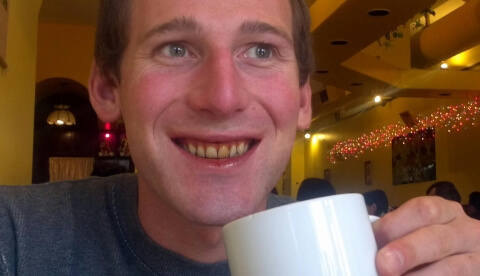
If you’ve had a knee injury, you can relate to my woes of knee pain. Despite the low impact of swimming, an extremely high incidence of knee pain was documented both among breaststroke specialists (73%) and nonbreaststrokers (48%). Don’t worry if you have knee pain you’re not alone!
If you haven’t had knee pain, this article is even more up your alley, because a knee injury is something I don’t wish upon anyone. Remember it is easier to prevent than rehabilitate!
Why Breast?
Breaststroke is the unique stroke in swimming. Many breaststrokers are commonly one-stroke ponies (dolphins? Not sure what aquatic animal is equivalent).
Breaststroke requires a high degree of knee flexion (nearly 130 degrees) with large hip internal rotation (approximately 40 degrees), combined with hip abduction and adduction. Knee flexion and hip internal rotation allows the foot to travel far away from the midline of the body, while hip adduction snaps the feet together during the inkick. These contorted positions compress the outside of the knee and stretches the inside of the knee. Stretching the medial knee component is most problematic and is the most common site of knee pain in swimmers, as one study found most swimmers with knee pain had pain on the medial aspect of the knee.
There are many tissues and structures on the inside of the knee which can be disturbed with excessive kicking or improper biomechanics. These tissues include: medial meniscus, medial collateral ligament, pes anserine (gracilis, sartorius and semitendinosis), medial portion of knee cap, and many bursae (fluid filled cushion sacs), just to name a few.
Tips to prevent breaststroker’s knee
Use Less Hip Abduction
Although no research study has associated a statistical difference between biomechanics and knee pain, they have found larger amounts of hip abduction during the kick are believed to contribute to knee pain. Think about it, if an athlete does not have adequate hip internal rotation (very common), and then the athlete will attempt to spread their legs further apart. This separation decreases the contact area of the knee on the medial side, increasing joint stress. Make sure your athletes are keeping thighs approximately hip width apart, with their feet moving wider with hip internal rotation, not hip adduction!
Hip Abduction
Hip Adduction
Warm-up properly
This simple training adjustment helps circulate blood throughout the body and decreases the viscosity of synovial (joint) fluid providing lubrication and healthier joints. Don’t be “in a hurry” or think “you’re impervious” to injury, you are susceptible at any age, warm-up properly with a dynamic warm-up in all planes of motion! Perform proper warm-up outside and inside the pool to prevent knee injuries. This should include cardiovascular warm-up, targeted muscular activation, and dynamic mobility.
Dryland Tip: Dynamic Hip Mobility
Mobilize those Hips
Our heavy sitting society provides stiff hips. If the body is stiff at the hips, then it will search for an area to compensate. In swimming, the body will use the sacrifice knee stability with knee mobility. This increase in knee mobility stresses many structures, especially on the inside of the knee.
Too often a swimmer hurts their knee, goes to a rehabilitation specialist who focuses only on the knee. Then the swimmer returns to training, leading to re-injury at their knee. Make sure to mobilize the hip to offload stress, just because the injury is at the knee, doesn’t mean another area wasn’t the cause!
The knee is often the result of a deficit at another body part. Poor hip mobility in every direction can lead to knee pain, especially in swimmers. If you don’t have the full hip rotation, then you will compensate with hip abduction excess knee mobility.
Stop if it hurts!!
This simple rule of thumb is often ignored. No matter the exercise: running, squatting, jogging, swimming, kung-fu fighting, or any exercise, if you start to have pain, stop!
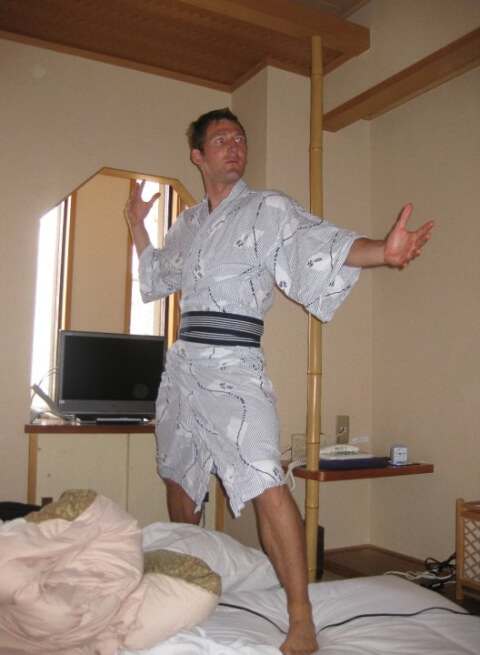
Anyone on the street can advise this brain wrenching idea, but it is surprisingly ignored. Exercising through pain causes inflammation and perpetuates a musculoskeletal injury.
Sometimes, the pain goes away after a day because fatigue was the cause. During fatigue the body searches for range of motion the wrong way. If the range of motion is not coming from the correct areas, then the knee is likely to be stressed.
Another cause of knee pain may be inflammation. For example, you were fatigued and used improper muscles during your kick a muscle strain can occur. A muscle strain starts with an inflammatory phase directly correlated with the degree of the injury. If a slight strain, give the knee a day rest in combination of ice and proper diet to improve the inflammation, and then return to the pool without any pain.
If you have to take a day off of breast kick to improve your knee pain, do it! Missing a day instead of a week creates success in the long haul. Every time you exercise you need to work on getting better, this is impossible if you’re injured.
Improve your diet!
Many diets promote high inflammation. Our fast food culture encourages consumption of pro-inflammatory foods.
polyunsaturated
Sunflower oil
Processed foods
Vegetable oil
Anything with Omega-6
A high inflammatory diet causes irritation in the joint encouraging joint injury. A simple fix is cutting down on saturated fats and Omega-6s intake, while improving your Omega-3 profile. This adjustment will improve your cholesterol and body inflammation.
One simple way to improve your Omega-3 profile is to add chia seeds on your food (personal favorite of Russ Payne)! These seeds carry minimal taste and are easy to throw on anything!
Another simple method is to consume a fish oil liquid supplement once a day. One teaspoon taste better than you would think and will tremendously enhance your Omega-3 profile.
Decrease Breast Volume
Many research studies suggest that reducing or eliminating breaststroke training volume to prevent knee injury. Obviously, if you are headed to Olympic Trials or have your season ending meet around the corner, then decreasing the volume of breast may not be possible. However, if you do have a break in the season, or don’t have high breast aspirations, decrease the volume of breast and give your knee a break!
Wake up your Butt!
The glutes control hip mobility and many studies associate poor glute strength in people with knee pain. These studies did not look at swimmers, but I don’t think we are different. In fact, simply activating the glutes is a tough, specifically gluteus maximus and the posterior fibers of the gluteus medius, for many swimmers.
Successfully activating the glutes and learning how to use them is essential for knee health and injury prevention in breast. Not many swimmers have a large butt, but most elite breast swimmers do have some junk in their trunk, don’t think this is coincidental! Learn to activate the glutes, and then start increasing their strength.
Stay tuned for more tips next week!
G. John Mullen is the owner of of the Center of Optimal Restoration and creator of Swimming Science. He received his doctorate in Physical Therapy at the University of Southern California. G. John has been featured in Swimming World Magazine, Swimmer Magazine, and the International Society of Swim Coaches Journal.




